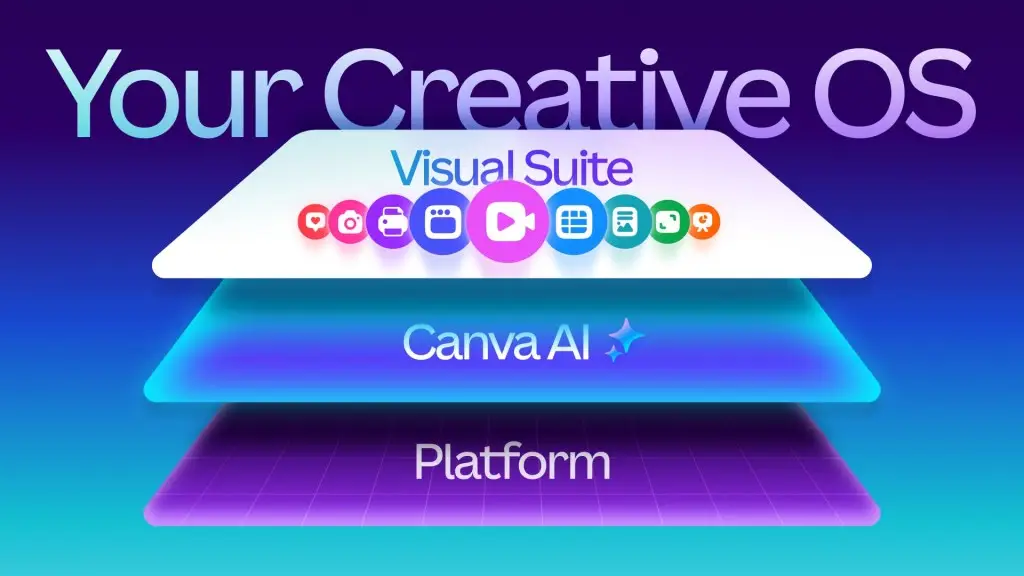Imagine you want to design a poster, a presentation, or a website. You open an app, type a few words, and instantly get a design with editable parts like text, images, and layers you can move.
That is what Canva just announced: its very own AI design model and a host of new smart tools. This appears to bring big changes not just for hobby designers, but for marketers, teams, and companies too.
What’s new
Canva’s new model is called a “foundational design model,” trained on the company’s library of design elements. Unlike older tools that produced flat images you couldn’t edit in parts, this model builds designs with layers you can work on. For example, instead of a single image file, you’ll get a file where you can click text, change images, move elements, or adjust colors.
This tool works across many formats: social media posts, presentations, whiteboards, websites, boards. Canva’s global head of product, Robert Kawalsky, said that people want to “start with a prompt and get far, but also be able to iterate directly themselves.” That means you give it instructions, the model creates a design, and then you adjust it. The aim is to give users more control while still benefiting from AI.
Smart design tools and upgrades
Alongside the new model, Canva also updated its AI assistant, which is now available in more parts of the app. You can now mention the assistant in comments to get text or media prompts during team work. It can generate 3D objects, copy art styles from existing designs, and offer smarter design suggestions.
The app also now lets users work with data more smartly. Canva added a spreadsheet tool and a widget-maker so you can turn data into visual insights. Think: you import numbers into Canva and it helps you build a small app or widget to display that data in a design. This is a big step for teams who work with both marketing visuals and analytics.
Marketing tools like Canva Grow
Canva is not just focusing on design. It is also building for marketers. The company is launching Canva Grow, a full marketing suite powered by AI. It combines ad creation, analytics, and publishing features. Canva recently acquired ad-analytics startup MagicBrief to boost this side of the business. With Canva Grow, marketers can create visuals, track performance, and publish ads to platforms like Meta directly from Canva.
In addition, Canva now supports features like its own version of forms (like Google Forms), email design templates (for brand marketing or transactional mail), and a free professional design suite called Affinity (which Canva acquired and now offers for free forever). The integration between these tools lets you move from professional design layout in Affinity to Canva’s new AI-design model smoothly.
Why this matters
If you are not a designer, these changes might sound technical, but they matter a lot. Here’s why:
- More control and less work: You don’t just get a flat image. You get an editable file. That means you can tweak things easily instead of starting from scratch.
- Design tools meet data tools: With spreadsheet and widget features, your visuals can pull in real data, making them more useful for business or team work.
- Marketers get an all-in-one tool: Canva Grow aims to reduce the need for multiple apps (design, ad creation, analytics) and bring all of that into one place.
- More professional tools, more accessible: With the free Affinity integration and the powerful AI model, more users will have access to tools previously reserved for pros.
- Competition steps up: This puts Canva in direct competition with big names like Adobe. If Canva can provide powerful tools that are easy to use, it could shift the industry.
What it means for users
If you use Canva now or plan to use it, here is what you should know:
- Try the new design model: When available, test how editable layers work. See how quickly you can modify parts of a design.
- Use the AI assistant: Incorporate it into your workflow. Tag the assistant, ask for suggestions, let it help you create faster.
- Leverage data visuals: If you work with numbers or analytics, explore the new widget and spreadsheet tools. They can help turn raw data into design without leaving Canva.
- Explore marketing features: If you handle marketing or ads, keep an eye on Canva Grow. It might simplify your tool stack.
- Learning curve: Even though Canva is making things easier, new tools will still require some learning. Some AI-generated content might need tweaking. Be patient and give it time.
What comes next
While Canva rolled out many features now, there are more updates expected. The company said that features like deeper vector editing, new body of templates, and more integrations will come. Also, designers should watch how professional tools like Affinity evolve in integration with Canva. The future will likely include even smarter AI tools, more formats, and greater ease of use for teams.
The Bottom Line
Canva’s launch of its own design model and the addition of new AI features mark a big milestone in design tools. It shows that creative work, data work, and marketing work are increasingly overlapping, and Canva wants to be at the center of that. Whether you are a designer, a marketer, or someone making visuals for fun, these changes will affect how you create.
Design is no longer just about pushing pixels. It’s about smart tools, smooth workflows, and personalization. With this update, Canva is signalling that it wants to make high-end design and AI power available to everyone.
If you use visual tools, this may be the moment to explore what’s new. Try it out. See whether you can go from “I need a visual” to “I made this” faster and easier than before.
Also Read:ElevenLabs CEO Says AI Audio Models Will Be ‘Commoditized’ Over Time

